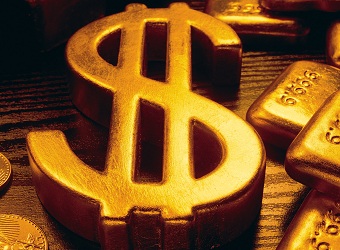Gold prices steadied on Friday, erasing earlier losses as the dollar came under pressure from a U.S. payrolls report that flagged up weak wage growth last month, weakening the case for near-term interest rate hikes.
The dollar fell versus the euro and U.S. Treasury yields eased after the jobs report for January.
While non-farm payrolls increased by 227,000 jobs last month, the largest gain in four months, the Labor Department said average hourly earnings increased only three cents or 0.1 percent.
Spot gold was at $1,217.56 an ounce, up 0.1 percent. U.S. gold futures for April delivery were 0.02 percent lower at $1,219.2.
“Markets seem to be looking at the soft wage data, which signal rather weak inflationary pressure, and therefore less need for the Fed to raise interest rates,” Commerzbank analyst Carsten Fritsch told the Reuters Global Gold Forum in the wake of the report.
“The U.S. dollar is weakening, bond yields decline, so the reaction of gold prices totally makes sense,” Fritsch added.
Gold is on track to rise 2.1 percent this week, its biggest weekly increase since early November, as the dollar headed for a fourth weekly drop on worries about Donald Trump’s presidential style and a lack of clarity on rate hikes.
The precious metal hit its highest since Nov. 17 on Thursday at $1,225.30 an ounce after a Federal Reserve policy statement disappointed investors hoping for clearer signs on interest rate hikes, knocking the dollar to a 12-week low.
A strong U.S. payrolls report would have increased the possibility of a rate hike as early as March.
Gold is highly sensitive to rising U.S. interest rates, which increase the opportunity cost of holding non-yielding bullion while boosting the dollar, in which it is priced.
Holdings of the world’s largest gold-backed exchange-traded fund, SPDR Gold Shares, rose for a second day on Thursday by 1.5 tonnes to 811.22 tonnes.
A bounce in investment to a four-year high drove a modest gain in gold demand last year, data from the World Gold Council showed on Friday, even as use of the metal in jewellery slid to its lowest since 2009 and coin and bar buying slid.
“ETF inflows were the sole driver of demand growth in 2016 – we saw the second highest inflows since 2009,” the WGC’s head of market intelligence Alistair Hewitt said.
Silver was down 0.1 percent at $17.41, having reached its highest in more than 11 weeks at $17.73 in the previous session.
Platinum was up 0.3 percent at $1003.30, having hit a 12-week high of $1,011.60 on Thursday, while palladium was 1.29 percent lower at $747.25.
Source: Reuters



